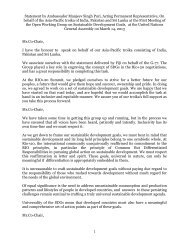STATE OF THE WORLD'S CITIES 2012/2013 Prosperity
STATE OF THE WORLD'S CITIES 2012/2013 Prosperity
STATE OF THE WORLD'S CITIES 2012/2013 Prosperity
Create successful ePaper yourself
Turn your PDF publications into a flip-book with our unique Google optimized e-Paper software.
Chapter 2.5<br />
Environmental<br />
Sustainability and the<br />
<strong>Prosperity</strong> of Cities<br />
The prosperity and environmental sustainability of cities are<br />
inextricably linked. Urban areas consume huge amounts of<br />
environmental goods and services like food, water, energy,<br />
forestry, building materials, and ‘green’ or open spaces often<br />
beyond their boundaries. This undermines the assimilative<br />
capacity of the environment around urban areas. 1 For<br />
example, the cities of the world generate over 720 billion<br />
tons of wastes every year, but in developing regions, even<br />
in large, presumably more<br />
affluent, cities only 25 to<br />
55 per cent of wastes are<br />
collected. 2 Demographic<br />
and spatial expansion can<br />
be so rapid as to outstrip<br />
the capacity of cities to<br />
provide basic amenities −<br />
housing, water and<br />
sanitation, etc. − resulting<br />
in poor urban conditions. 3<br />
FACT Environmentally<br />
sustainable cities<br />
are likely to be more<br />
productive, competitive,<br />
innovative, and prosperous<br />
enough to provide better<br />
preservation for the<br />
environment and enhance<br />
quality of life and well-being<br />
for all the population.<br />
POLICy<br />
Inasmuch cities are sources of environmental<br />
problems within and beyond their jurisdictions,<br />
they are also best-placed to provide most of the solutions.<br />
Environmentally sustainable cities are able to draw a healthy<br />
balance between economic growth and the environment, and<br />
facilitate prosperity and resilience in the process. 4<br />
78<br />
A key message is that prosperous cities can operate<br />
efficiently and productively without damaging the<br />
environment. 5 This is possible only when environmental<br />
and social objectives are fully integrated in a city’s overall<br />
economic goals to help bring about environmental<br />
sustainability. 6<br />
ENvIRONMENTAL SUSTAINABILITy IN <strong>CITIES</strong><br />
It is generally assumed that any country can preserve<br />
the environment while maintaining economic growth. 7<br />
However, a degree of commitment is required from all<br />
Solar panel assembly at a Suntech factory in Wuxi, China. A high<br />
percentage of China's homes use solar-heated water.<br />
© Qilai Shen/Panos Pictures




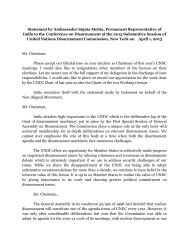



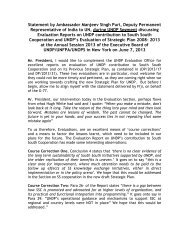


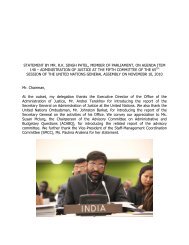

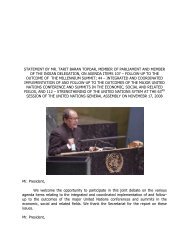

![1 statement by dr.[mrs] kakoli ghosh dastidar - Member States Portal](https://img.yumpu.com/27526598/1/190x245/1-statement-by-drmrs-kakoli-ghosh-dastidar-member-states-portal.jpg?quality=85)
